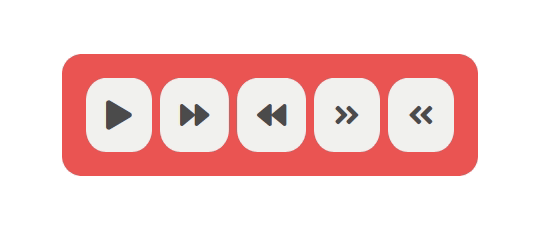Creating an audio player with React
Bài đăng này đã không được cập nhật trong 6 năm
Intro
I wanted to create a custom audio player which can be easily styled or modified to events. So here it is.
with vanilla
Lets create a pure vanilla custom audio player. The html5 player is hard to customize in look an feel to match your site's style. For this, we'll design a custom one.
<div class="player">
<audio id="player"</audio>
<button id="play"></button>
<button id="forward"></button>
<button id="backword"></button>
<button id="next"></button>
<button id="prev"></button>
</div>
Note here we are using the html audio component, but it won't be shown in the browser ( we didn't add the controls property)
Adding font-awesome icons to our button we get
<button id="play"><i id="playIcon" class="fas fa-play"></i></button>
<button id="forward"><i class="fas fa-forward"></i></button>
<button id="backword"><i class="fas fa-backward"></i></button>
<button id="next"><i class="fas fa-angle-double-right"></i></button>
<button id="prev"><i class="fas fa-angle-double-left"></i></button>
Now we delegate our button click events to the appropriate audio player event.
const player = document.getElementById("player");
const playButton = document.getElementById("play");
const forwardButton = document.getElementById("forward");
const backwordButton = document.getElementById("backword");
const playIcon = document.getElementById("playIcon");
const togglePlaybackIcon = () => {
playButton.classList.toggle("focused");
playIcon.classList.toggle("fa-pause");
playIcon.classList.toggle("fa-play");
}
player.onended = togglePlaybackIcon;
playButton.onclick = () => {
player.paused ? player.play() : player.pause();
togglePlaybackIcon();
};
forwardButton.onclick = () => {
if(!player.paused) {
player.currentTime += 1
}
};
backwordButton.onclick = () => {
if(!player.paused) {
player.currentTime -= 1
}
};
let's add some style to the page
div.player {
background: #e20000ab;
padding: 10px;
border-radius: 10px;
width: fit-content;
}
button {
border-radius: 30%;
padding: 10px;
border: none;
}
button:hover, button.focused {
background-color: mediumvioletred;
}
Now refresh the browser and voila!

the full html will be
<!DOCTYPE html>
<html lang="en">
<head>
<meta charset="UTF-8">
<meta name="viewport" content="width=device-width, initial-scale=1.0">
<meta http-equiv="X-UA-Compatible" content="ie=edge">
<title>Audio player</title>
<link rel="stylesheet" href="https://use.fontawesome.com/releases/v5.8.1/css/all.css" integrity="sha384-50oBUHEmvpQ+1lW4y57PTFmhCaXp0ML5d60M1M7uH2+nqUivzIebhndOJK28anvf" crossorigin="anonymous">
<link rel="stylesheet" href="styles.css">
</head>
<body>
<div class="player">
<audio id="player" src="break_it.mp3"></audio>
<button id="play"><i id="playIcon" class="fas fa-play"></i></button>
<button id="forward"><i class="fas fa-forward"></i></button>
<button id="backword"><i class="fas fa-backward"></i></button>
<button id="next"><i class="fas fa-angle-double-right"></i></button>
<button id="prev"><i class="fas fa-angle-double-left"></i></button>
</div>
<script>
const player = document.getElementById("player");
const playButton = document.getElementById("play");
const forwardButton = document.getElementById("forward");
const backwordButton = document.getElementById("backword");
const playIcon = document.getElementById("playIcon");
const togglePlaybackIcon = () => {
playButton.classList.toggle("focused");
playIcon.classList.toggle("fa-pause");
playIcon.classList.toggle("fa-play");
}
player.onended = togglePlaybackIcon;
playButton.onclick = () => {
player.paused ? player.play() : player.pause();
togglePlaybackIcon();
};
forwardButton.onclick = () => {
if(!player.paused) {
player.currentTime += 1
}
};
backwordButton.onclick = () => {
if(!player.paused) {
player.currentTime -= 1
}
};
</script>
</body>
</html>
with react
Now we convert it to a React component.
our goal is to create a component which we can just call like
<Player source="./track1.mp3" />
or send a list of tracks like
<Player source={[
"./track1.mp3",
"./track2.mp3",
"./track3.mp3"
]} />
or if we want to show the information of current track as notification popups (not implemented here, but can be done just modifying few things)
<Player source={[
{
title: "la isla bonita",
artist: "Alizee",
image: "./image.jpg",
track: "./track.mp3"
},
{
....
},
{
....
}
]} />
So, lets create a react project now.
For that we'll use the create-react-app npm package to generate our boilerplate
npx create-react-app react-audio-player
next, cd inside the app, let's create two different files touch src/Player.js src/Player.css
Also have a look at the package.json
{
"name": "react-audio-player",
"version": "0.1.0",
"private": true,
"dependencies": {
"react": "^16.8.6",
"react-dom": "^16.8.6",
"react-scripts": "^2.1.8"
},
"devDependencies": {},
"scripts": {
"start": "react-scripts start",
"build": "react-scripts build",
"test": "react-scripts test --env=jsdom",
"eject": "react-scripts eject"
},
"browserslist": [
">0.2%",
"not dead",
"not ie <= 11",
"not op_mini all"
]
}
it's almost all we need. We'll be adding one more package to make coding a little easier.
npm i -s underscore
Now let's create our Player.js
import React, { Component } from 'react';
import _ from 'underscore';
import './Player.css';
class Player extends Component {
constructor(props) {
super(props);
let track = "";
if(Array.isArray(this.props.source)) {
track = this.props.source[0];
} else {
track = this.props.source;
}
this.state = {
source: this.props.source,
track: track
}
this.playClick = this.playClick.bind(this);
this.togglePlaybackIcon = this.togglePlaybackIcon.bind(this);
this.forwardClick = this.forwardClick.bind(this);
this.backwordClick = this.backwordClick.bind(this);
this.previousTrackClick = this.previousTrackClick.bind(this);
this.nextTrackClick = this.nextTrackClick.bind(this);
}
componentDidMount = () => {
const player = document.getElementById("player");
if(!player.paused) {
this.togglePlaybackIcon();
}
}
togglePlaybackIcon = () => {
const playButton = document.getElementById("play");
const playIcon = document.getElementById("playIcon");
playButton.classList.toggle("focused");
playIcon.classList.toggle("fa-pause");
playIcon.classList.toggle("fa-play");
}
playClick = (doNotToggleIcon = false) => {
const player = document.getElementById("player");
player.paused ? player.play() : player.pause();
this.togglePlaybackIcon();
};
forwardClick = () => {
const player = document.getElementById("player");
if(!player.paused) {
player.currentTime += 1
}
};
backwordClick = () => {
const player = document.getElementById("player");
if(!player.paused) {
player.currentTime -= 1
}
};
nextTrackClick = () => {
if(Array.isArray(this.state.source)) {
let currentTrackIndex = _.indexOf(this.state.source, this.state.track);
let nextTrack = this.state.source[currentTrackIndex+1]
if(nextTrack === undefined) {nextTrack = this.state.track}
this.setState({
track: nextTrack
})
this.playClick();
}
};
previousTrackClick = () => {
if(Array.isArray(this.state.source)) {
let currentTrackIndex = _.indexOf(this.state.source, this.state.track);
let previousTrack = this.state.source[currentTrackIndex-1]
if(previousTrack === undefined) {previousTrack = this.state.track}
this.setState({
track: previousTrack
})
this.playClick();
}
};
render() {
return (
<div className="player">
<audio id="player" onEnded={this.togglePlaybackIcon} src={this.state.track}></audio>
<button id="play" onClick={this.playClick}><i id="playIcon" className="fas fa-play"></i></button>
<button id="forward" onClick={this.forwardClick}><i className="fas fa-forward"></i></button>
<button id="backword" onClick={this.backwordClick}><i className="fas fa-backward"></i></button>
<button id="next" onClick={this.nextTrackClick}><i className="fas fa-angle-double-right"></i></button>
<button id="prev" onClick={this.previousTrackClick}><i className="fas fa-angle-double-left"></i></button>
</div>
);
}
}
export default Player;
It's almost exactly the same as our html component, just in react syntax. Also our player will have a state of it's own
this.state = {
source: this.props.source,
track: track
}
we get the source from props, and we set the playing track by checking the type of source.
Also, let's implement the nextTrack and previousTrack functions
nextTrackClick = () => {
if(Array.isArray(this.state.source)) {
let currentTrackIndex = _.indexOf(this.state.source, this.state.track);
let nextTrack = this.state.source[currentTrackIndex+1]
if(nextTrack === undefined) {nextTrack = this.state.track}
this.setState({
track: nextTrack
})
this.playClick();
}
};
previousTrackClick = () => {
if(Array.isArray(this.state.source)) {
let currentTrackIndex = _.indexOf(this.state.source, this.state.track);
let previousTrack = this.state.source[currentTrackIndex-1]
if(previousTrack === undefined) {previousTrack = this.state.track}
this.setState({
track: previousTrack
})
this.playClick();
}
};
Now we just import it in our App.js
import React, { Component } from 'react';
import Player from './Player.js';
class App extends Component {
render() {
return (
<div className="App">
<Player source={["./track01.mp3", ".mp3"]} />
</div>
);
}
}
export default App;

source code
git: https://github.com/SSalekin/react-audio-player
running the app
git clone https://github.com/SSalekin/react-audio-player
cd react-audio-player
npm i
npm start
All rights reserved